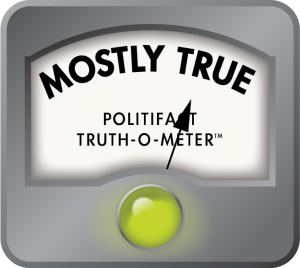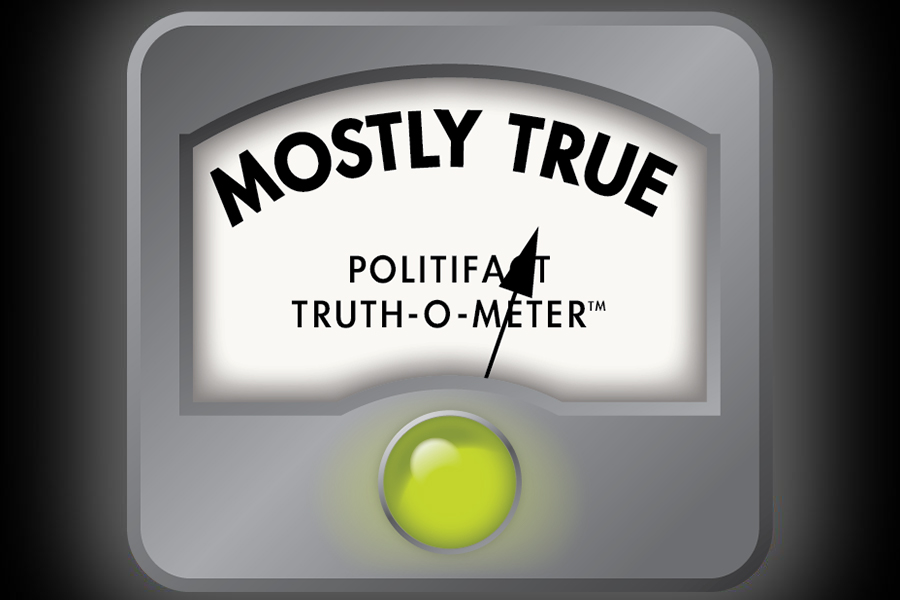Fact Check | About 70 percent of U.S. residents expected to live in the 15 largest states in 2040
J.D. Scholten, a former Democratic nominee for Iowa’s 4th Congressional District and senior policy advisor at American Economic Liberties Project, tweeted that 70 percent of the population is expected to live in just 15 states in 2040.
August 5, 2021
PolitiFact Iowa is a project of The Daily Iowan’s Ethics & Politics Initiative and PolitiFact to help you find the truth in politics.
Edited by Lyle Muller and Rachel Schilke
If your time is short:
- Recent census data from the University of Virginia’s Cooper Center shows that about 70 percent of the U.S. population will live in the 15 largest states in 2040.
- While population projections need to be updated every two or three years to capture accurate population trends, former Iowa congressional candidate J.D. Scholten’s tweet matches the U.S. Census Bureau’s most recent projections.
- PolitiFact has shown previously that concerns that the population shift will change the balance of power in Washington, D.C., are overstated.
Data from 2017 predicting Americans’ domestic migration patterns are resurfacing after J.D. Scholten, a former Democratic nominee for Iowa’s 4th Congressional District and senior policy advisor at American Economic Liberties Project, tweeted July 21:
“By 2040, 70% of the population is expected to live in just 15 states.”
He linked his comment to an article, “Rural America’s Population Loss Stems from Outmigration, Not Deaths,” by The Daily Yonder.
The U.S. Census Bureau defines domestic migration as the movement of people within the nation’s boundaries, from one state to another, while international migration refers to the movement across the boundaries.
Migration has researchers, politicians and others interested in how power in Congress gets distributed. States’ representation in the U.S. House is determined by population, while representation in the U.S. Senate is two senators per state, regardless of size.
“My view of that is that when you look at our democracy, the amount of influence smaller populated states will have by 2040 is going to increase dramatically, where more populated states won’t have the same weight,” Scholten said in an interview with PolitiFact Iowa.
PolitiFact checked the balance of power question earlier this year and found those concerns to be overstated. But, while we cannot fact-check whether or not something in the future will happen, we can check on whether or not Scholten cites credible population projection data.
Scholten said his tweet is based on a 2017 Wall Street Journal column, “The Varied—and Global—Threats Confronting Democracy,” by Gerald Seib. Seib wrote that David Birdsell, a political communications scholar and provost and senior vice president of Kean University, noted that by “2040, about 70% of Americans are expected to live in the 15 largest states.”
In an interview with PolitiFact Iowa, Birdsell, who made his projection while at Baruch College, said figures he quoted for Seib’s article referenced U.S. Census Bureau data analyzed by the Weldon Cooper Center for Public Service at the University of Virginia. But while the data are a few years old, they still generally hold up in 2021, he said.
The Cooper Center used the most recent population estimates and U.S. Census Bureau data to examine expected changes between 2020 and 2040, the center’s website said.
“Any population projection is exactly that,” Birdsell said. “It’s based on circumstances at the time, it’s based on lifespan, It’s based on immigration rates, it’s based on naturalization rates, from among the immigrant population.”
The article, “How accurate are our 50-State population projections?” about the Cooper Center’s population projections, states that projections recognized as authentic tend to be accurate within a small percentage margin of U.S. Census Bureau numbers that are released years later. In addition, the article says population projections need to be updated every two or three years to capture accurate population trends.
For analyzing Scholten’s tweet, that means the Cooper Center’s most recent data can have a margin of error, but is still providing comparable projections since 2017, according to The Cooper Center.
According to a Cooper Center article “National Population Projections: 2020, 2030, 2040” by Shonel Sen, research and policy analyst for the Demographics Research Group, the top 10 largest states have been “projected to remain the same across the decades since 2010.”
Data show that some southern states, like Georgia and North Carolina, are gradually growing because the states have younger populations. Meanwhile, populations in smaller states, like Vermont and West Virginia, would be expected to decrease consistently, largely because of people there are aging, the Cooper Center reports. “California, Texas, Florida and New York continue to dominate the population size charts, with more than a third of the future U.S. population residing in one of these four large states,” Sen wrote.
According to calculations by PolitiFact using U.S. Census Bureau data and population projections from the Cooper Center, an estimated 67.2 percent of the U.S. population will live in the 15 largest states in 2040.
| 2021 Rank | U.S. State | US Census 2020 State Estimates | Estimated % of population in U.S. 2020 | 2040 Population Projection | Estimated % of population in U.S. 2040 |
| 1 | California | 39,538,223 | 11.9 | 46,467,001 | 12.3 |
| 2 | Texas | 29,145,505 | 8.8 | 40,015,913 | 10.3 |
| 3 | Florida | 21,538,187 | 6.5 | 28,886,983 | 7.6 |
| 4 | New York | 20,201,249 | 6.1 | 20,873,488 | 5.5 |
| 5 | Pennsylvania | 13,002,700 | 3.9 | 12,809,150 | 3.4 |
| 6 | Illinois | 12,812,508 | 3.9 | 12,397,564 | 3.3 |
| 7 | Ohio | 11,799,448 | 3.6 | 11,751,540 | 3.1 |
| 8 | Georgia | 10,711,908 | 3.2 | 12,820,271 | 3.4 |
| 9 | North Carolina | 10,439,388 | 3.2 | 12,658,927 | 3.4 |
| 10 | Michigan | 10,077,331 | 3.0 | 9,960,115 | 2.6 |
| 11 | New Jersey | 9,288,994 | 2.8 | 9,470,012 | 2.5 |
| 12 | Virginia | 8,631,393 | 2.6 | 9,876,728 | 2.6 |
| 13 | Washington | 7,705,281 | 2.3 | 9,776,126 | 2.6 |
| 14 | Arizona | 7,151,502 | 2.2 | 9,166,279 | 2.4 |
| 15 | Tennessee | 6,910,840 | 2.1 | 7,823,662 | 2.0 |
| % Total | 66.0 (rounded) | 67.2 (rounded) | |||
| Top 15 state population total | 218,954,457 | 254,753,759 | |||
| Total U.S.
population |
331,449,281 | 379,392,779 |

Our ruling
Scholten said, “By 2040, 70% of the population is expected to live in just 15 states.”
The Cooper Center, the catalyst for Scholten’s tweet, has a credible history of national population predictions with small error margins. The center’s data projects that an estimated 67.2 percent of the U.S. population will live in the 15 largest states in 2040, which is close to Scholten’s 70 percent.
Adding in the uncertainty inherent in any projection, that’s enough to rate this claim Mostly True.
Sources
J.D. Scholten Twitter, “By 2040, 70% of the population is expected to live in just 15 states,” July 21, 2021
PolitiFactIowa Interview with J.D. Scholten, former Democratic nominee for Iowa’s 4th congressional district, July 26, 2021
PolitiFactIowa Interview with David Birdsell, Kean University provost and senior vice president, Aug. 4, 2021
Kean University news release, “Kean Appoints Nationally Recognized Communication Scholar as Top Academic Leader,” June 10, 2021
PolitiFact, “Fact-checking Barack Obama on the Senate filibuster,” June 1, 2021
The Daily Yonder, “Rural America’s Population Loss Stems from Outmigration, Not Deaths,” July 21, 2021
The Wall Street Journal, “The Varied—and Global—Threats Confronting Democracy,” Nov. 21, 2021
U.S. Census Bureau, “Domestic Migration Across Regions, Divisions, and State,” August 2003
The Washington Post, “By 2040, two-thirds of Americans will be represented by 30 percent of the Senate,” Nov. 28, 2017.
University of Virginia Weldon Cooper Center Demographics Research Group, “National Population Projections: 2020, 2030, 2040,” Feb. 11, 2019
Qian Cai and Shonel Sen, “How accurate are our 50-State population projections?,” May 12, 2021
U.S. Census Bureau, “U.S. and World Population Clock,” accessed July 27, 2021
U.S. Census Bureau, “Geographic Mobility by Selected Characteristics in the United States”, state population estimates from 2010-2019
U.S. Census Bureau, “A Preliminary Analysis of U.S. and State-Level Results From the 2020 Census,” April, 2021



